Agritourism Activity—A “Smart Chance” for Mountain Rural Environment’s Sustainability
Abstract
1. Introduction
- -
- Tourist activities should not replace the agricultural ones, but they should come in as their support, as complementary activities, especially in problematic areas;
- -
- While designing the tourism offer, the emphasis must be placed on the characteristics of life in the country, combining the resources specific to the rural environment with agricultural products, so as to maintain the purpose of being a sustainable activity from the rural environment.
- -
- The production of high-quality agricultural products;
- -
- The contribution to the diversity of agricultural products on the European market;
- -
- The conservation of animal and plant species, the preservation of traditions;
- -
- To carry out industrial and tourist activities;
- -
- To combat climate change by protecting biodiversity.
1.1. Literature Review
- -
- The essence of agritourism taking into consideration agricultural activity. Agritourism is a hybrid concept [34] that connects two special sectors—tourism with agriculture—in order to open new and profitable market niches for farm products and services, without becoming a dominant agricultural sector, and it can play an important contribution for many farms, by supporting them. The business choices must be made by independent farming families, when confronting the need to diversify away from traditional agricultural activities through developing farm-based tourism businesses [30].
- -
- The essence of agritourism taking into consideration the development of rural communities. Due to its strong local identity, agritourism becomes a real possibility to consolidate the local economy given its recognized positive effects on generating income and jobs. Moreover, its ability to create a certain dynamism in the upstream and downstream sectors and activities promotes it as a rural economy’s source of growth and diversification [35,36], determining the development of new market niches, the increase of interest in local agricultural products, the opportunity to reintroduce/keep some lands in the agricultural circuit, on-site employment for population situated in rural areas, and insurance of the most wanted aspect in the long term. All these mean sustainability for agricultural activities.
- -
- The essence of agritourism taking into consideration its specific of being a form of rural tourism. Agritourism represents a subcategory of rural tourism that involves the capitalization on the surplus in the household/tourist farm through the prism of the tourist product. This product incorporates the components of a tourist product, but with some specific aspects [3]:
- -
- Regarding the first element, namely accommodation, it is achieved by capitalizing the surplus of the accommodation places from the farm, guesthouse, villas, and tourist services while being integrated into the farm and household, and by intersecting with the ordinary activity of the farmer;
- -
- Regarding the second element, namely food, this comes from their own production, in certain variable percentages. For instance, the services are provided by the farmer’s family, in other words, there is a direct connection between the bidder of specific agritourist services and the tourist requesting these services;
- -
- Regarding the third element, namely leisure, the emphasis is put on participating in the traditional activities of the farm or guesthouse.
- -
- The tourist offer is authentic, based on the specifics of the area, on its special features;
- -
- Direct contact with specific plant species that are cultivated, with specific animals and types of animal husbandry, with types of forestry, mushrooming, wild vegetables and fruits, with the landscape, rural daily life, rural customs and practices, allows knowledge of the rural environment and familiarization of citizens with country life;
- -
- A way of education, of responsibility towards daily tasks, especially if we are referring to children;
- -
- Additionally, the reception places are spread over the whole rural area, the accommodation being particularized by a rustic character, so the tourists can spend their free time in various geographical conditions (mountain, hill, plain) at lower prices and rates than in the case of classic tourism.
- -
- Starting from the special emphasis placed on the origin and development of the conditions of the tourism area [47],
- -
- -
- -
- For tourists, it can offer authentic, original products, with an emphasis on farm life (education, responsibilities), organic gastronomic products and contact with nature;
- -
- For local entrepreneurs/farmers it can be, in some cases, the saving solution in capitalizing on their own production, but also the possibility to acquire a new qualification;
- -
- For the agritourism area, it can be a sustainable chance because it can generate jobs, capitalize on products and local crafts, ensuring the increase of living standards.
1.2. Aim and Objectives
- Identifying the essence of agritourism activity, of differences compared to rural tourism and of the reason why there is a link between agritourism and sustainability.
- Presenting some aspects regarding the favorability for agritourism activity (taking into consideration the existing potential), in order to achieve a general image of tourism potential from these two regions: Apuseni Mountains and Alps Mountains-Trento Province.
- Determining the extent in which agritourism activity from the two areas is considered, a possibility of own economic growth and development by the owners.
- Identifying some management strategies in order to support the role of agritourism activity as a future “smart chance” for mountain rural environment’s sustainability.
2. Materials and Methods
- -
- Identification of the owners of agritourism structures’ characteristics from the two areas: Alps Mountains-Trento Province and Apuseni Mountains;
- -
- Identification of farmers’ motivation from the two regions for carrying out agritourism activity, and how they understand/see the agritourism activity;
- -
- Identification of the aspects related to the capitalization of the two locations through agritourism activities, namely specialized training for agritourism activity, the existence of tourist and access infrastructure, the dimension and approach of the agricultural activity developed by the owner;
- -
- Identification of some aspects related to the extent in which agritourism activity, from the two areas, is considered by the owners a possibility of own economic growth and development, through the
- -
- Identification of some management strategies to support the improvement of the agritourism activity/product, so as to transform agritourism in a “smart tool” for alternative income sources and ensuring sustainability of the local community.
- Establishing the purely agritourist structures which, to be taken under study, represented a problematic aspect;
- Another problem was the geographical areas of the research, which, being very large, have generated a longer period of time for the application of questionnaires.
- In the Alps Mountain-Trento Province area, there are a total number of 328 agritourist structures. We tried to take into consideration the structures with representativeness for agritourism activity. We intended to survey 150 structures from each area, but not all owners wanted to participate in our study. In the case of the Italian area, the problem of time also arose, so we considered, as being valid, only those questionnaires to which the owners fully answered, respectively, 119 answers/structures.
- The Romanian area has approximately 285 agritourism structures; initially, we proposed to introduce, in the study, the same number of 150 structures. However, even in this case, the time, the large geographical area and the fact that not all the owners wanted to answer our questions determined us to take into consideration 142 answers/structures.
3. Results
3.1. Presentation of Some Aspects from the Areas of the Research—Curent Situation and Comparisons
- -
- A literature review on key aspects regarding agritourism activity and his benefits;
- -
- Comparing the two mountain areas: Apuseni Mountains and Alps Mountains-Trento Province to achieve a general image;
- -
- Identifying the extent in which agritourism is or can be a possibility of own economic growth and development;
- -
- Proposals of some measures to ensure a future support of agritourism activity in order to be a suitable sustainable chance for rural environment.
- -
- Protect, qualify and enhance the specific resources of each territory;
- -
- Promoting the maintenance of human activities in rural areas;
- -
- Favor multifunctionality in agriculture and the differentiation of agricultural incomes; encourage initiatives to protect the soil, the territory and the environment by agricultural entrepreneurs while increasing company incomes and improving the quality of life;
- -
- Recover the rural building heritage by protecting the landscape peculiarities;
- -
- Support and encourage typical products, quality products and related food and wine traditions;
- -
- Promoting rural culture and food education; promoting agricultural and forestry development.
- (a)
- As food suppliers and as the main source of ensuring the existence of the population;
- (b)
- As an activity that absorbs the available labor force.
- -
- Private producers in the area agree to sell products directly from the household, being motivated by the lack of taxation for the sale of goods in different market segments;
- -
- There is no organized network for processing the specific products of the area that would interest the producer and thus create its own network based on cooperation;
- -
- The village does not represent certain offers able to direct the specific products towards modern forms of processing and commercialization through which to stimulate the producing inhabitants.
3.2. Determination of the Extent in Which Agritourism Activity, from the Two Areas, Is Considered a Possibility of Own Economic Growth and Development by the Owners
3.2.1. Identifying the Characteristics of the Agritourism Structures’ Owners, from the Two Areas: Alps Mountains-Trento Province and Apuseni Mountains
3.2.2. Identification of the Manner in Which Owners Understand Agritourism and their Motivation for Carrying out this Activity
3.2.3. Identification of the Aspects Related to the Capitalization of the Two Locations through Agritourism Activities
3.2.4. Identification of the Aspects Related to the Extent in which Agritourism Activity Is Considered by the Owners a Possibility of Own Economic Growth and Development
- -
- Firstly, to remain a secondary activity to agriculture, not to replace it, having as purpose to revitalize unprofitable activities, by capitalizing through tourism activities their own products and rural activities specific to life in mountain regions;
- -
- Then, to use, in creating the agritourist product, all strengths/resources of the area, traditional crafts or local customs, focusing on educating tourists to enjoy the life on mountain rural farms.
3.2.5. Identification of Some Management Strategies to Support the Improvement of the Agritourism Activity/Product, so as to Transform Agritourism into a “Smart Tool”
4. Discussion
- -
- It connects agricultural activities with tourism ones (namely agricultural production, procession activities with the elements of tourist product: accommodation, food and leisure). Tourism activity must be developed as a complementary activity to agriculture, and it should not become a substitute for this.
- -
- It combines all agricultural resources from the rural mountain areas, and resources of the farm, with natural resources, cultural resources, and also with rural community traditions, which can be a starting point to create agritourist products, with multiple benefits.
- -
- -
- Rural entrepreneurs have the possibility to use traditional activities existent in the mountain rural communities, sustaining, in this way, the revival and continuous practice of these ancestral activities and supporting their preservation;
- -
- The possibility to improve the relationship between urban versus rural by “smart” using/capitalizing rural products/resources through tourism, stopping the chaotic development and sustaining the capitalization of representative features of rural mountain areas; in this way, encouraging urban citizens to visit and to love rural areas;
- -
- More attention on the environment, meaning the “raw material” for agritourism, by supporting the preservation of the viability and stability of rural mountain localities, by creating ways of diversifying rural economies of rural areas through eco-agriculture, crafts and traditions through a “smart” tourism.
5. Conclusions
- Identification of the motivations of farmers for carrying out agritourism activity, and how they understand/see the agritourism activity. From this point of view, in the case of the Italian area, the ecological motivation through which agritourism is seen as, “a new lifestyle, combining agriculture with human relations”, is the most important, supporting somehow the sustainability of this activity for the mountainous rural environment. In the second analyzed area, the Romanian one, the ecological motivation through which agritourism is seen as, “a new lifestyle, combining agriculture with human relations”, is the least important, the explanation deriving from the fact that in this area, the agritourism activity is at the beginning, and its profitability—the incomes obtained from this activity being lower—therefore, the accent on the sustainability is also much lower. Starting from here, a first proposal derives, which, for the Romanian area that is less consolidated on the agritourism market, may represent a “smart chance” for this activity, namely: focus on defining by law the agritourism activity, and also establishing the stages and objectives of this activity for rural entrepreneurs (Table 3 and Table 7 as proposals).
- Identification of the aspects for supporting the capitalization of the two areas through agritourism activities is another studied aspect. So, we find that rural entrepreneurs do not prepare in advance for developing this activity, and they perceive it as a way of increasing the value of the agricultural farm through their own efforts and other activities. If, in the case of the Italian area, referring to the lack of infrastructure, we discuss only the infrastructure needed for the leisure part; in the case of the Romanian area, we discuss especially about the lack of access infrastructure and then about the one necessary for the developing tourist activity. Therefore, even if from the point of view of the agritourism potential, the two mountainous rural areas are comparable, from the point of view of the degree of development of the agritourism activity, there are major differences of development. Regarding the dimension and approach of the agricultural activity developed by the owner, we also find some differences between the two areas:
- -
- Italian area has a large dimension of the farm, ensuring, in this way, an economic viability— first, as farmers, and then, as entrepreneurs in agritourist activity,
- -
- Identification of some aspects, related to the extent in which agritourism activity is viewed as a possibility of own economic growth and development, is the third aspect pursued. Consequently. we discover that agritourism activity is a “smart chance” for rural mountain Italian area, and it can be a possible lever to combat many existing disparities from Romanian area. In the creation process of agritourism product, both areas put, in the second place, the use of the local/own products/gastronomy. Making a comparison between the two areas, the findings reveal that:
- -
- in the case of the Italian area, we find specialized, diversified and quantitatively higher production, obtained in farms with large dimensions (economically speaking),
- -
- in the case of the Romanian area, the products are obtained mostly in small farms, of semi-subsistence, but the owners have an advantage: many of these products are organic. The conclusion that emerges is that both areas try to include the specific features that characterize each area in the agritourism product, trying through different means to differentiate themselves from other tourist destinations (Table 5).
- To support the localities with high potential from the two analyzed areas, a series of strategies identified by local owners of agritourist structures are necessary: Increasing the visibility of agritourist structures through road signaling; ensuring some support (financial or consulting); support for establishing/creating of the agritourism structures (Table 6 and Table 7 as proposals).
Author Contributions
Funding
Acknowledgments
Conflicts of Interest
References
- Page, S.; Getz, D. The Business of Rural Tourism: International Perspectives; International Thomson Business Press: London, England, 1997; Volume 4. [Google Scholar]
- Phillip, S.; Hunter, C.; Blackstock, K. A typology for defining agritourism. Tour. Manag. 2010, 31, 754–758. [Google Scholar] [CrossRef]
- Lupi, C.; Giaccio, V.; Mastronardi, L.; Giannelli, A.; Scardera, A. Exploring the features of agritourism and its contribution to rural development in Italy. Land Use Policy 2017, 64, 383–390. [Google Scholar] [CrossRef]
- Ciolac, R.; Adamov, T.; Iancu, T.; Popescu, G.; Lile, R.; Rujescu, C.; Marin, D. Agritourism-A Sustainable Development Factor for Improving the ‘Health’ of Rural Settlements. Case Study Apuseni Mountains Area. Sustainability 2019, 11, 1467. [Google Scholar] [CrossRef]
- Evgrafova, L.V.; Ismailova, A.Z.; Kalinichev, V.L. Agrotourism as a factor of sustainable rural development. In IOP Conference Series: Earth and Environmental Science, Proceedings of the 2nd International Scientific Conference, Krasnoyarsk, Russia, 13–14 November 2019; IOP Publishing: Krasnoyarsk, Russia, 2019. [Google Scholar]
- Garcia, H.B. Marketing în Turism Rural; Editura Irecson: Bucureşti, Romania, 2003. [Google Scholar]
- Legge n. 96/20 Febbraio 2006, “Disciplina Dell’agriturismo”, Pubblicata Nella Gazzetta Ufficiale n. 63 del 16 Marzo 2006. Available online: https://www.camera.it/parlam/leggi/06096l.htm (accessed on 7 December 2019).
- Chiodo, E.; Fantini, A.; Dickes, L.; Arogundade, T.; Lamie, R.D.; Assing, L.; Stewart, C.; Salvatore, R. Agritourism in Mountainous Regions-Insights from an International Perspective. Sustainability 2019, 11, 3715. [Google Scholar] [CrossRef]
- Ispas, A.; Untaru, E.N.; Candrea, A.N. Environmental Management Practices within Agritourism Boarding Houses in Romania: A Qualitative Study among Managers. Sustainability 2019, 11, 3887. [Google Scholar] [CrossRef]
- Pasquilini, B.; Jacquot, B. Tourism en Europe. In Action Touristique; Dounod: Paris, France, 1992. [Google Scholar]
- Ramakrishnan, P.S. Redeveloping Mountain Landscapes as Cultural Cradles of Biodiversity. IHDP Update 2008, 2, 63–69. [Google Scholar]
- Teti, V. Il Senso dei Luoghi: Memoria e Storia dei Paesi Abbandonati; Donzelli: Roma, Italy, 2004. [Google Scholar]
- Chiodo, E.; Finocchio, R.; Sotte, F. Diversificazione multifunzionale nell’impresa agricola e trasformazioni del paesaggio agrario. Ital. J. Agron. 2009, 3, 41–46. [Google Scholar] [CrossRef]
- Bock, B.B. Rural Marginalisation and the Role of Social Innovation; ATurn Towards Nexogenous Development and Rural Reconnection. Sociol. Rural. 2016, 56, 552–573. [Google Scholar] [CrossRef]
- Neumeier, S. Social innovation in rural development: Identifying the key factors of success. Geogr. J. 2017, 183, 34–46. [Google Scholar] [CrossRef]
- Ghereş, M. Agroturism, de la Tradiţie la Ofertă Comercială; Editura Risoprint: Cluj-Napoca, Romania, 2003. [Google Scholar]
- Bausch, T. Le Tourisme et l’ Environnement en Europe; Office dest Publications Officielles des Communautes Europeennes: Luxemburg, 1995. [Google Scholar]
- Rey, R. European Context and the Crisis State from Romanian Agriculture and Mountain Rural Area, Out of the Volume Rural World-Today and Tomorrow-Coord.acad; Cristian Hera; Editura Academiei Române: Bucureşti, Romania, 2006. [Google Scholar]
- Abrudan, I.; Turnock, D.A. Rural development strategy for the Apuseni Mountains, Romania. GeoJournal 1998, 46, 319–336. [Google Scholar] [CrossRef]
- Euromontana. Către dezvoltarea integrată a zonelor montane și recunoașterea acestora în cadrul politicii agricole comune. Modelarea Noului Spațiu European. In Proceedings of the Euromontana Conference, Piatra Neamț, Romania, 4–6 October 2007. [Google Scholar]
- Comisia Europeană. O Selecție a Celor Mai Bune Practici Leader+; Comisia Europeană: Brussels, Belgium, 2009. [Google Scholar]
- RNDR. Bune Practici, 2014, No. 4 Anul II, USR, Departamentul Publicaţii MADR. Available online: http://madr.ro (accessed on 11 December 2019).
- Vaetisi, S. Rural tourism in the Apuseni Mountains, Romania. An anthropological research on using natural and cultural resources in developing tourism in a poor region. In Devesh Nigam, Babu; George, P., Ed.; Tourists and Tourism: New Delhi, India, 2007; pp. 40–52. ISBN 978-8188683994. [Google Scholar]
- Rusu, S. Turism Rural şi Agroturism; Editura Mirton: Timişoara, Romania, 2007. [Google Scholar]
- Panyik, E.; Costa, C.; Ratz, T. Implementing integrated rural tourism: An event-based approach. Tour. Manag. 2011, 32, 1352–1363. [Google Scholar] [CrossRef]
- Ohe, Y. Evaluating operators’ attitudes to educational tourism in dairy farms: The case of Japan. Tour. Econ. 2012, 18, 577–595. [Google Scholar] [CrossRef]
- Nidumolu, R.; Prahalad, C.K.; Rangaswami, M.R. Why sustainability is now the key driver of innovation. Harvard Bus. Rev. 2009, 87, 56–64. [Google Scholar]
- Ko, D.W.; Stewart, W.P. A structural equation model of residents’ attitudes for tourism development. Tour. Manag. 2002, 23, 521–530. [Google Scholar] [CrossRef]
- Kim, K.; Uysal, M.; Sirgy, J. How does tourism in a community impacts the quality of life of community ersidents? Tour. Manag. 2013, 36, 527–540. [Google Scholar] [CrossRef]
- Domenico, M.D.; Miller, G. Farming and tourism enterprise: Experiential authenticity in the diversification of independent small-scale family farming. Tour. Manag. 2012, 33, 285–294. [Google Scholar] [CrossRef]
- Eurac Research. Outcome Statement 1st World Congress on Agritourism. 20577-59518. Available online: http://agritourism.eurac.edu (accessed on 7 November 2019).
- Ammirato, S.; Felicetti, A. The Agritourism as a Means of Sustainable Development for Rural Communities: A Research from the Field. Int. J. Interdiscip. Environ. Stud. 2014, 8, 17–29. [Google Scholar] [CrossRef]
- Glăvan, V. Turism Rural, Agroturism, Turism Durabil, Ecoturism; Editura Economică: Bucureşti, Romania, 2003. [Google Scholar]
- Poon, A. Competitive Strategies for a “New Tourism”. In Classic Reviews in Tourism; Cooper, C., Ed.; Channel View: Clevedon, UK, 2003; pp. 130–142. [Google Scholar]
- Khan, A.; Bibi, S.; Lorenzo, A.; Lyu, J.; Babar, Z.U. Tourism and development in developing economies: A policy implication perspective. Sustainability 2020, 12, 1618. [Google Scholar] [CrossRef]
- Marin, D. Study on the economic impact of tourism and of agrotourism on local communities. Res. J. Agric. Sci. 2015, 47, 160–163. [Google Scholar]
- Stock, P.; Burton, R.J.F. Defining terms for integrated (multi-inter-trans-disciplinary) sustainability research. Sustainability 2011, 3, 1090–1113. [Google Scholar] [CrossRef]
- Shepherd, D.A.; Patzelt, H. The New Field of Sustainable Entrepreneurship: Studying Entrepreneurial Action Linking “What Is to Be Sustained” With “What Is to Be Developed”. Entrep. Theory Pract. 2011, 35, 137–163. [Google Scholar] [CrossRef]
- Jauhari, V. Managing Sustainability in the Hospitality and Tourism Industry; Apple Academic Press Inc.: Oakville, ON, Canada, 2014; Volume 67. [Google Scholar]
- Li, B.; Mi, Z.; Zhang, Z. Willingness of the new generation of farmers to participate in rural tourism: The role of perceived impacts and sense of place. Sustainability 2020, 12, 766. [Google Scholar] [CrossRef]
- Nepal, S.K.; Chipeniuk, R. Mountain Tourism: Toward a Conceptual Framework. Tour. Geogr. 2005, 7, 313–333. [Google Scholar] [CrossRef]
- Lane, B.; Kastenholz, E. Rural tourism: The evolution of practice and research approaches-towards a new generation concept? J. Sustain. Tour. 2015, 23, 1133–1156. [Google Scholar] [CrossRef]
- Belz, F.M.; Binder, J.K. Sustainable Entrepreneurship: A Convergent Process Model. Bus. Strategy Environ. 2017, 26, 1–17. [Google Scholar] [CrossRef]
- Butkouskaya, V.; Romagosa, F.; Noguera, M. Obstacles to Sustainable Entrepreneurship amongst Tourism Students: A Gender Comparison. Sustainability 2020, 12, 1812. [Google Scholar] [CrossRef]
- Li, Y.; Hu, C.; Huang, C.; Duan, L. The concept of smart tourism in the context of tourism information services. Tour. Manag. 2016, 58, 293–300. [Google Scholar] [CrossRef]
- Gretzel, U.; Sigala, M.; Xiang, Z.; Koo, C. Smart tourism: Foundations and developments. Electron. Mark. 2015, 25, 179–188. [Google Scholar] [CrossRef]
- Zhang, L.; Li, N.; Liu, M. On the basic concept of smarter tourism and its theoretical system. Tour. Trib. 2012, 27, 66–73. [Google Scholar]
- Perfetto, M.C.; Vargas-Sánchez, A. Towards a Smart Tourism Business Ecosystem based on Industrial Heritage: Research perspectives from the mining region of Rio Tinto. J. Herit. Tour. 2018, 13, 528–549. [Google Scholar] [CrossRef]
- Available online: https://www.mediafax.ro/life-inedit/cnn-lauda-peisajele-din-muntii-apuseni-cel-mai-bine-pastrat-secret-din-europa-de-est-timpul-sta-pe-loc-aici-video-18439721 (accessed on 16 March 2020).
- Yin, R.K. Case Study Research: Design and Methods; Sage: London, UK, 2003. [Google Scholar]
- Saaty, T.L. The Analytic Hierarchy Process: Decision Making in Complex Environments. In Quantitative Assessment in Arms Control; Avenhaus, R., Huber, R.K., Eds.; Springer: Boston, MA, USA, 1984; ISBN 978-1-4612-9727-7. [Google Scholar] [CrossRef]
- Hepu, D. Multicriteria analysis with fuzzy pairwise comparison. Int. J. Approx. Reason. 1999, 21, 215–231. [Google Scholar]
- Bernard, R.; Philippe, V. Multicriteria analysis: Survey and new directions. Eur. J. Oper. Res. 1981, 8, 207–218. [Google Scholar]
- Rozman, C.; Zek, K.P.; Bavec, M.; Bavec, F.; Turk, J.; Majkovic, D. The multicriteria analysis of spelt food processing alternatives on small organic farms. J. Sustain. Agric. 2006, 28, 159–179. [Google Scholar] [CrossRef]
- Meyer, C.B. A Case in Case Study Methodology. Field Methods 2001, 13, 329–352. [Google Scholar] [CrossRef]
- Stake, R.E. The Art of Case Study Research; Sage: Thousand Oaks, CA, USA, 1995. [Google Scholar]
- Marradi, A.; Archenti, N.; Piovani, J.I. Metodología de las Ciencias Sociales; Emecé: Buenos Aires, Argentina, 2007. [Google Scholar]
- Ramona, C.; Cornelia, P.; Ioan, P.; Ciprian, R.; Sorin, S.; Simona, M. Andreea Romana Tucudean, Research of Agro Tourism Stage and Traditional Products through Activity in the Alps Mountain Trento Province. In Proceedings of the Sixth International Conference “Rural Development 2013: Innovations and Sustainability”, Kaunas, Lithuania, 28–29 November 2013; Volume 6, pp. 74–79. [Google Scholar]
- Ramona, C. Capitalization local, traditional products through agrotourism-comparative case study Alps Mountains, Province of Trento-Apuseni Mountains. Sci. Pap. Anim. Sci. Biotechnol. 2014, 47, 292–296. [Google Scholar]
- Fanelli, R.M.; Romagnoli, L. Customer Satisfaction with Farmhouse Facilities and Its Implications for the Promotion of Agritourism Resources in Italian Municipalities. Sustainability 2020, 12, 1749. [Google Scholar] [CrossRef]
- Agritur in Trentino, on Web Page Agriturismotrentino. Available online: www.agritourismo.it (accessed on 2 April 2020).
- Google Maps. Available online: https://www.google.com/search?q=muntii+apuseni+harta (accessed on 2 April 2020).
- National Institute of Statistics. Available online: http://statistici.insse.ro (accessed on 4 February 2020).
- Adamov, T.; Ciolac, R.; Iancu, T.; Brad, I.; Peț, E.; Popescu, G.; Șmuleac, L. Sustainability of Agritourism Activity. Initiatives and Challenges in Romanian Mountain Rural Regions. Sustainability 2020, 12, 2502. [Google Scholar] [CrossRef]
- Hall, D.; Kirkpatrick, I.; Mitchell, M. Rural Tourism and Sustainable Business; Channel View Publications: Bristol, UK, 2005. [Google Scholar]
- Font, X.; Mccabe, S. Sustainability and marketing in tourism: Its contexts, paradoxes, approaches, challenges and potential. J. Sustain. Tour. 2017, 25, 869–883. [Google Scholar] [CrossRef]
- Giannakis, E.; Efstratoglou, S.; Antoniades, A. Off-Farm Employment and Economic Crisis: Evidence from Cyprus. Agriculture 2018, 8, 41. [Google Scholar] [CrossRef]
- Schneider, S.; Niederle, P.A. Resistance strategies and diversification of rural livelihoods: The construction of autonomy among Brazilian family farmers. J. Peasant Stud. 2010, 37, 379–405. [Google Scholar] [CrossRef]
- Vogt, L. The economic side of agrotourism: Business performance and competitive factors. Econ. Agro. Aliment. 2013, 26, 77–102. [Google Scholar] [CrossRef]
- Barbieri, C.; Mahoney, E. Why is diversification an attractive farm adjustment strategy? Insights from Texas farmers and ranchers. J. Rural Stud. 2009, 25, 58–66. [Google Scholar] [CrossRef]
- Fabry, N. Agritourisme: Enjeux socio-économiques et impacts touristiques. Juristourisme 2011, 137, 20–22. [Google Scholar]
- Brouder, P. Creative Outposts: Tourism’s Place in Rural Innovation. Tour. Plan. Dev. 2012, 9, 383–396. [Google Scholar] [CrossRef]
- Feher, A.; Goşa, V.; Raicov, M.; Harangus, D.; Condea, B.V. Convergence of Romanian and Europe Union agriculture–evolution and prospective assessment. Land Use Policy 2017, 67, 670–678. [Google Scholar] [CrossRef]
- José, A.A.-S.; María, P.-R.; Juan, F.V.-M.; Francisco, M.-A. Worldwide research trends on sustainable land use in agriculture. Land Use Policy 2019, 87, 104069. [Google Scholar]
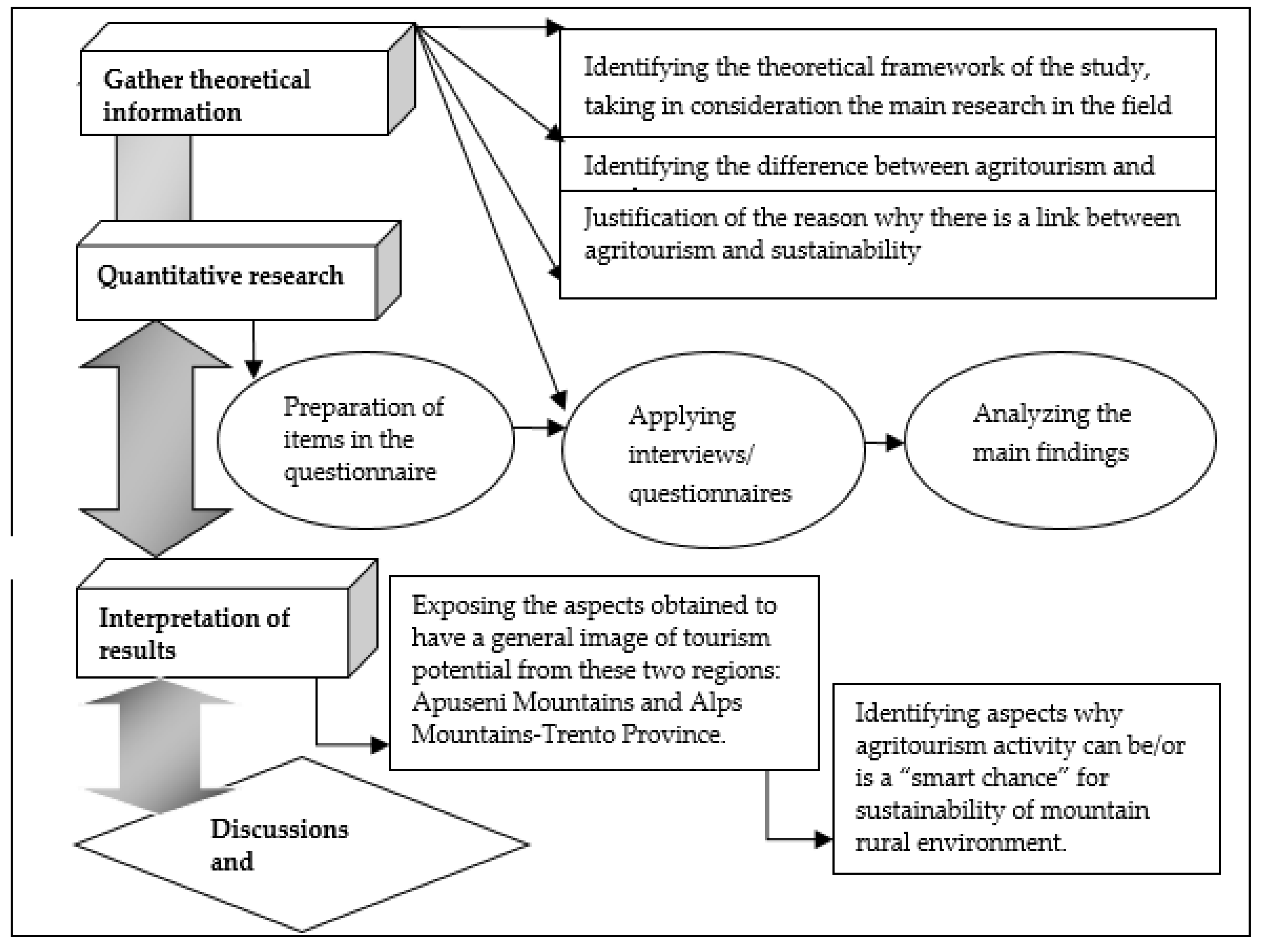
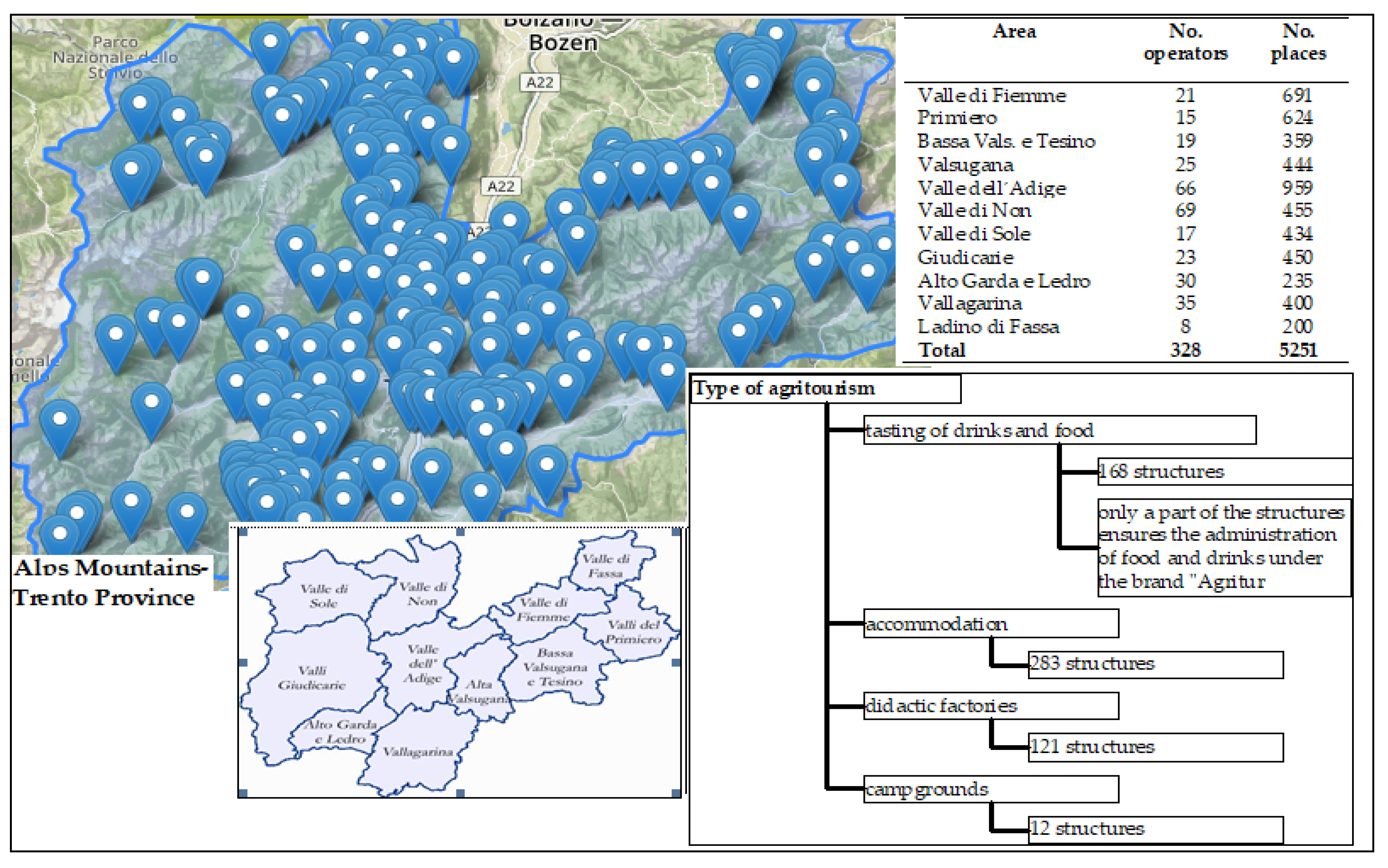
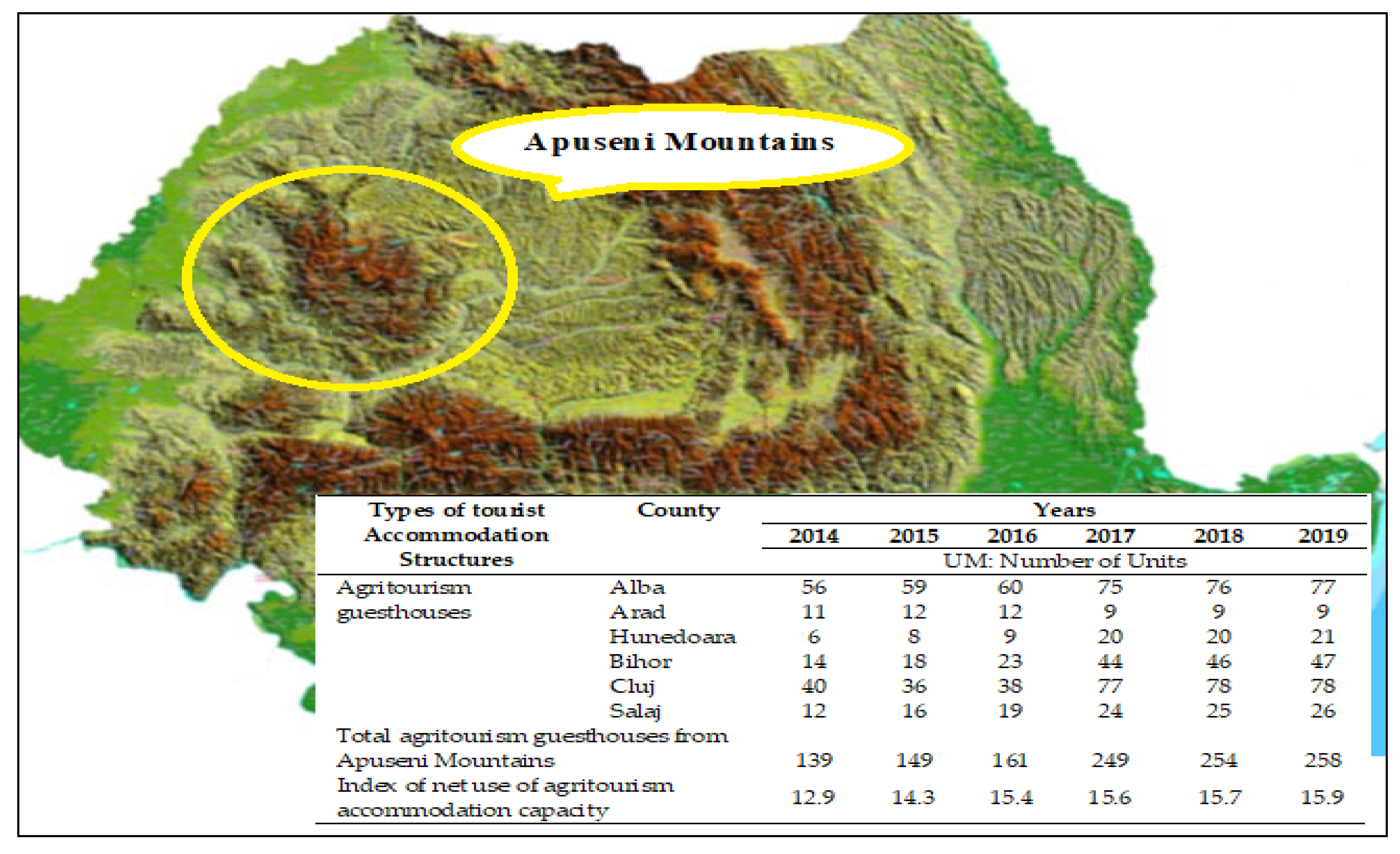
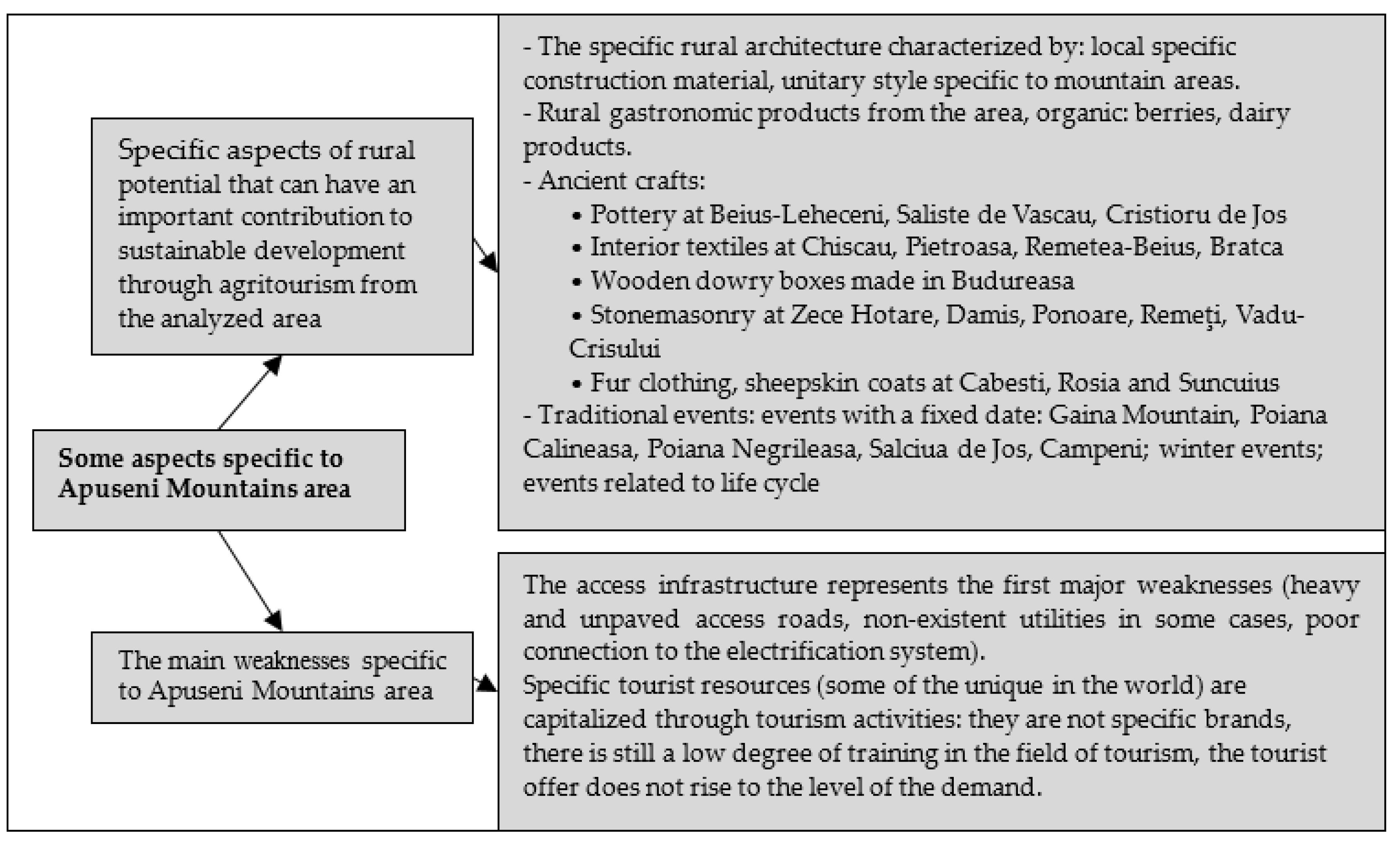
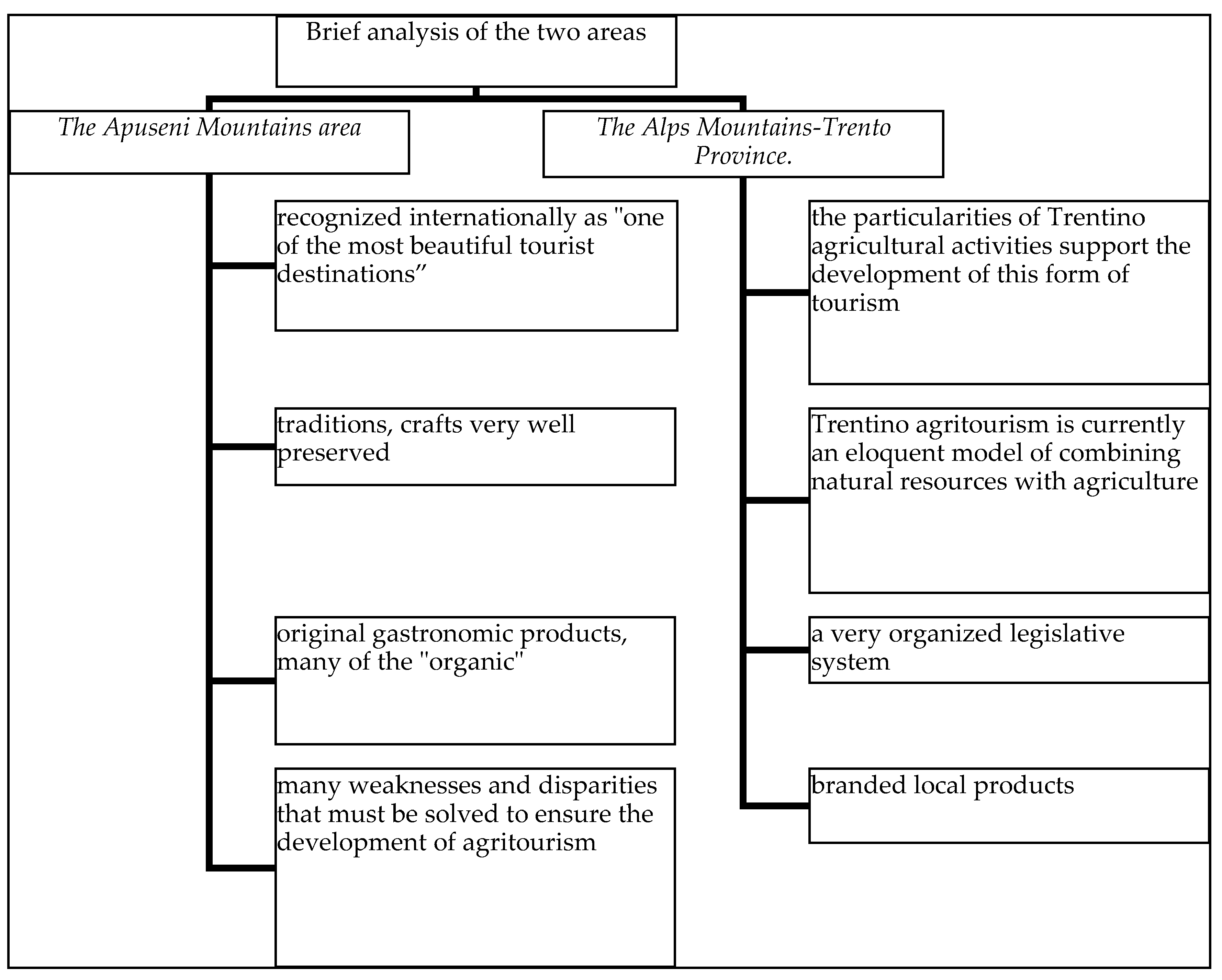
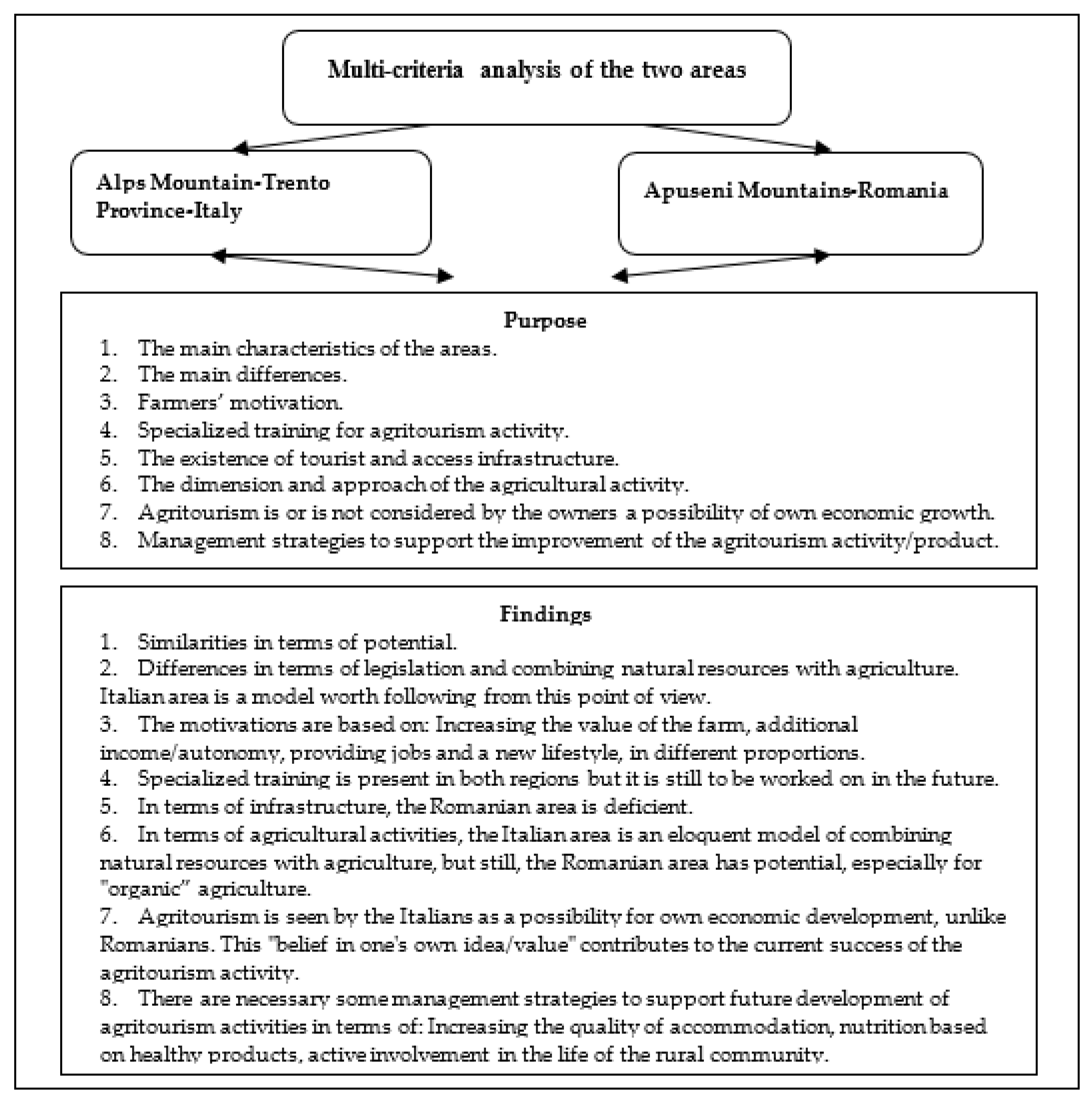
| Defining Agritourism Activity | The Main Elements Resulting from the Definition | Important Aspects and Advantages from Agritourism Activity |
|---|---|---|
| The essence of agritourism taking in consideration agricultural activity. | Is the special activity which unites agriculture and tourism. | Advantages for farmers and for the community
Benefits for tourists
|
| Appears in order to diversify traditional agricultural activities by starting farm-based tourism businesses [24]. | ||
| The essence of agritourism taking in consideration the development of rural communities. | Authentic possibility to consolidate the local economy. | |
| Its ability to create certain dynamism in the upstream and downstream sectors and activities. | ||
| A source of growth and diversification of the rural economy. | ||
| The essence of agritourism taking in consideration its specific of being a form of rural tourism. | Accommodation is achieved by capitalizing the surplus of the accommodation places from the farm, guesthouse, villas, and tourist services being integrated into the farm and household, and intersecting with the ordinary activity of the farmer. | |
| Food comes from own production, in certain variable percentages, the services being provided by the farmer’s family. | ||
| In case of leisure, the emphasis is put on participating in the traditional activities of the farm or guesthouse. |
| Studied Region | Measure Unit | Men | Women | Statistical Centralization | |
|---|---|---|---|---|---|
| No. of Questionnaires | % from Total No. of Structures from the Area | ||||
| Alps Mountains-Trento Province | No. | 78 | 41 | 119 | 36.28 |
| % | 65.54 | 34.45 | |||
| Apuseni Mountains | No. | 87 | 55 | 142 | 55.03 |
| % | 61.26 | 38.73 | |||
| Studied Region | Measure Unit | The Understanding of Agritourism Activity (a) | Owners’ Motivations for Carrying Out Agritourism Activity (b) | ||||
|---|---|---|---|---|---|---|---|
| Yes | No | A New Lifestyle | Additional Income/Autonomy | Providing Jobs | Increasing the Value of the Farm | ||
| Alps Mountains- Trento Province | No. | 102 | 17 | 32 | 16 | 29 | 42 |
| % | 85.71 | 14.28 | 26.89 | 13.44 | 24.37 | 25.29 | |
| Apuseni Mountains | No. | 51 | 91 | 7 | 54 | 33 | 48 |
| % | 35.91 | 64.08 | 4.93 | 38.03 | 23.23 | 33.80 | |
| Studied Region | Measure Unit | Specialized Training for Agritourism Activity (a) | The Existence of Tourist and Access Infrastructure (b) | Dimension and Approach of the Agricultural Activity Developed by the Owner by the Dimension of the Farm (c) | ||||
|---|---|---|---|---|---|---|---|---|
| Yes | No | Yes | No | 5.00–10.00 ha | 10.00–20.00 ha | 20.00–30.00 ha | ||
| Alps Mountains- Trento Province | No. | 48 | 71 | 104 | 15 | 24 | 73 | 22 |
| % | 40.33 | 59.66 | 87.39 | 12.60 | 20.16 | 61.34 | 18.49 | |
| Apuseni Mountains | No. | 44 | 98 | 45 | 97 | 103 | 32 | 7 |
| % | 30.98 | 69.01 | 31.69 | 68.31 | 72.53 | 22.53 | 4.93 | |
| Studied Region | Measure Unit | Is or Is Not Agritourism Activity a Possibility of Own Economic Development (a) | The Capitalization of Own Products Obtained in the Farm (b) | Identification of the Extent in Which the Strengths/Traditional Crafts/Rural Activities Existent in Two Areas Are Used in Creating the Agritourist Product (c) | |||||
|---|---|---|---|---|---|---|---|---|---|
| Yes | No | Yes | No | Use of the Strengths/Resources of the Area | Use of Rural Activities Specific to Life in Mountain Region | Use of the Local/Own Products/Gastronomy | Use of the Traditional Crafts or Local Customs | ||
| Alps Mountains- Trento Province | No. | 91 | 28 | 25 | 94 | 22 | 38 | 41 | 18 |
| % | 76.46 | 23.53 | 21.01 | 78.98 | 18.49 | 31.93 | 34.45 | 15.12 | |
| Apuseni Mountains | No. | 68 | 74 | 117 | 25 | 70 | 15 | 41 | 16 |
| % | 47.88 | 52.11 | 82.39 | 17.60 | 49.29 | 10.56 | 28.87 | 11.27 | |
| Studied Region | Measure Unit | The Involvement for Supporting Agritourism Activities from Specific Local Authorities | Management Strategies Necessary for Supporting the Future Development of Agritourism Activity/Product | ||||
|---|---|---|---|---|---|---|---|
| Yes | No | Some Actions | Increasing the Quality of Accommodation (1) | Nutrition Based on Healthy Products (2) | Active Involvement in the Life of the Rural Community (3) | ||
| Alps Mountains- Trento Province | No. | 102 | 17 | Increasing the visibility of agritourism structures through road signaling Ensuring some support (financial or consulting) | 17 | 49 | 53 |
| % | 85.71 | 14.28 | 14.28 | 41.17 | 44.54 | ||
| Apuseni Mountains | No. | 47 | 95 | Support for establishing/creating of the agritourism structures | 54 | 51 | 37 |
| % | 33.09 | 66.90 | 38.03 | 35.91 | 26.05 | ||
| General Objective | Specific priorities | Measures Proposed to Achieve the Established Priorities |
|---|---|---|
| Agritourism activity—a “smart chance” for mountain rural environment’s sustainability | Understanding the mean of agritourism activity | Carrying out information campaigns regarding the possibility of practicing agritourism activity highlighting its main advantages |
| Specialized training for agritourism activity | ||
| Establishing by law the characteristics and limits of the agritourism activity | ||
| Highlighting the motivations of owners for carrying out agritourism activity | Identification of the main resources and traditional products possible to be capitalized through agritourism | |
| Creating a partnership with producers from rural areas | ||
| Creating training programs at local level to include traditional resources and products in tourist circuit | ||
| The involvement of the local authorities in supporting agritourism activities | Increasing the visibility of agritourism structures through road signaling | |
| Ensuring some support (financial or consulting) | ||
| Support for establishing/creating of the agritourism structures | ||
| Technical assistance for the preparation of the necessary documentation | ||
| Proper management strategies | Increasing the quality of accommodation | |
| The incorporation in the agritourism product of the “way of life specific to community” | ||
| Capitalization of healthy food (obtained from own production, or from nature) directly through agritourism/agritourism product | ||
| Accent on promoting this activity | Establishing directions for promotion and framing them in a unitary framework | |
| Promotion by achieving: - tourist guides; - flyers; - websites and advertisements. |
© 2020 by the authors. Licensee MDPI, Basel, Switzerland. This article is an open access article distributed under the terms and conditions of the Creative Commons Attribution (CC BY) license (http://creativecommons.org/licenses/by/4.0/).
Share and Cite
Ciolac, R.; Iancu, T.; Brad, I.; Popescu, G.; Marin, D.; Adamov, T. Agritourism Activity—A “Smart Chance” for Mountain Rural Environment’s Sustainability. Sustainability 2020, 12, 6237. https://doi.org/10.3390/su12156237
Ciolac R, Iancu T, Brad I, Popescu G, Marin D, Adamov T. Agritourism Activity—A “Smart Chance” for Mountain Rural Environment’s Sustainability. Sustainability. 2020; 12(15):6237. https://doi.org/10.3390/su12156237
Chicago/Turabian StyleCiolac, Ramona, Tiberiu Iancu, Ioan Brad, Gabriela Popescu, Diana Marin, and Tabita Adamov. 2020. "Agritourism Activity—A “Smart Chance” for Mountain Rural Environment’s Sustainability" Sustainability 12, no. 15: 6237. https://doi.org/10.3390/su12156237
APA StyleCiolac, R., Iancu, T., Brad, I., Popescu, G., Marin, D., & Adamov, T. (2020). Agritourism Activity—A “Smart Chance” for Mountain Rural Environment’s Sustainability. Sustainability, 12(15), 6237. https://doi.org/10.3390/su12156237









